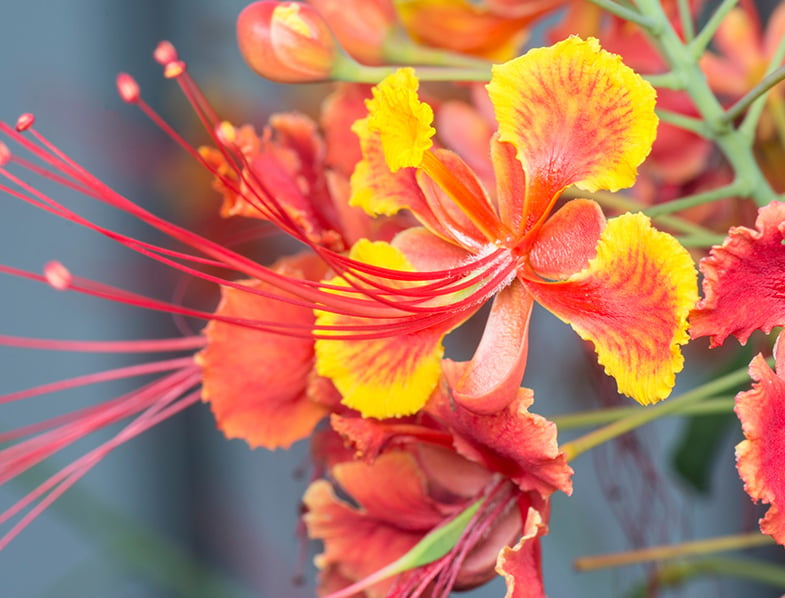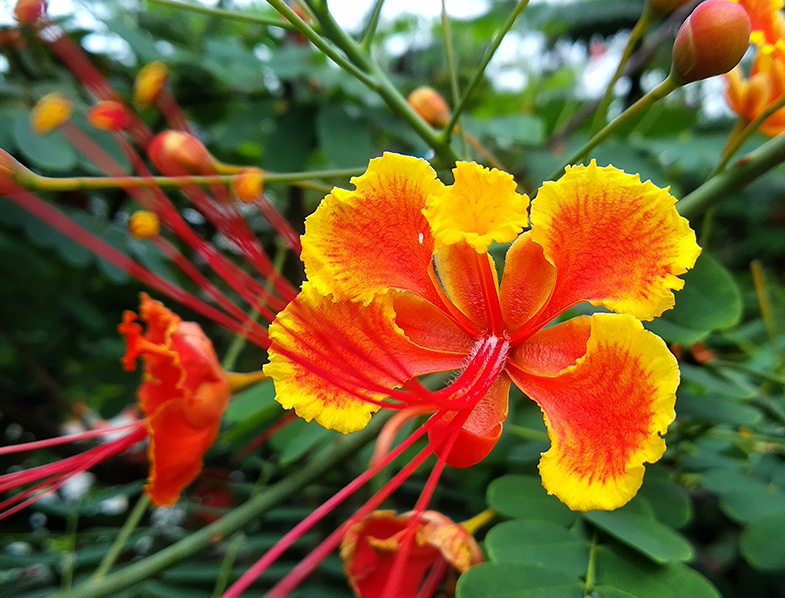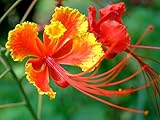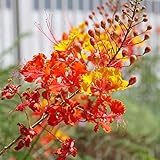Looking for an easy-to-grow shrub that will put a show from summer to fall in your garden? Look no further than Peacock Flower!
Caesalpinia Pulcherrima, or commonly known as Peacock Flower, is a spectacular tropical/subtropical shrub that produces bright orange flowers that will fill your garden with color and life. The beautifully colored flowers of the Peacock Flower resemble butterflies and they attract… well, unsurprisingly, butterflies and hummingbirds.
This shrub is so loved by growers that it has been given many fabulous names, from Red Bird of Paradise to Flamboyan-de-Jardin, and the Texas Superstar plant. What’s more, in 2012, it has received a Royal Horticulture Society Award of Garden Merit Winner. The term “pulcherrima” from its botanical name translates as “very pretty.”
Peacock Flower is a sun-loving plant and thrives in the hottest, sunniest sites of gardens. It’s perfect to be grown as a large shrub in zones 10 and 11. It can also be grown as a container plant.
Besides looking spectacular in any garden, the Peacock Flower also has plenty of medicinal uses. It has been used in ancient times as a medicine to cure minor injuries and to relieve fever. The flower is also known to have weight-loss benefits and anti-septic and anti-inflammatory properties. A boiled mixture of Peacock Flower’s leaves, bark, and rots is thought to relieve kidney pain, fever, sore throat, and gastrointestinal disorders, but we do not recommend trying this at home without your doctor’s consent.
Ready to learn more about how to grow and care for Peacock Flower? Keep reading below!
About Peacock Flower
- Native to the West Indies and to Mexico, Peacock Flower belongs to the family of Fabaceae.
- The botanical name of the Peacock Flower is Caesalpinia Pulcherrima. This flower has many other common names, including Dwarf Poinciana, Pride of Barbados Flower, and Paradise Flower.
- Peacock Flower is a striking ornamental plant that will thrive in gardens in areas with hot climates. Since it is a tropical plant, it does not tolerate cold temperatures well. Yet, if it finds a lot of sunlight and hot temperatures in your outdoor space, it will thrive, filling your garden with lovely bright colors.
- This shrub is really sun-loving and needs full sun to thrive when grown in outdoor spaces. When grown inside, it also needs a lot of sunlight, but not direct light. So, look for the sunniest spot in your garden to plant your Peacock Flower.
- Peacock Flower thrives in porous, sandy, well-drained soil. One of the most common problems with this plant is root rot. For this reason, you need to ensure that its soil provides optimal drainage.
- As mentioned above, Peacock Flower needs a warm climate to thrive as it is not cold-hardy. If grown outdoors, temperatures should preferably remain above 55°F (12°C) during the night and 70°F (21°C) during the day. These are the average preferred temperatures by this shrub.
- Although the immature seeds found in Peacock Flower’s green pods are known to be edible, the mature seeds are known to be toxic. So, whether you grow your Peacock Flower in your garden or inside your home, make sure you place it in a spot out of your kids’ and pets’ reach.
- The most common and serious pests that can affect your Peacock Flower are spider mites. This plant can also become the victim of aphids and scale insect infestation. If the leaves of your shrub start turning yellow or they drop off, or if there are visible spots in leaf surfaces, these can be signs of pest infestation. To treat pest infestations, you can use horticultural oil or insecticidal soap. Aphids can be removed with a spray of cold water.

Peacock Flower Features: An Overview
- Caesalpinia Pulcherrima is a fast-growing shrub that can reach heights of up to 15 feet (3m) and grow up to 6 to 10 feet (1,8- 3 m) wide.
- Peacock Flower has bushy growth with fern-like foliage. It features thin stems and delicate leaves that emerge from spiny stems and branches. It has rapid growth, requiring lots of space to develop.
- In the blooming season, during the summer months, Peacock Flower produces red and orange flowers that resemble butterflies.
- The flowers it produces have a delightful scent. Growers believe that the fragrance of Peacock Flowers alone is a good enough reason to grow this plant in your garden.
Growing Peacock Flower
Despite its intimidating and unique appearance, growing Peacock Flower is actually really easy. There are a few basic growing conditions that this shrub needs to survive. As long as you provide your flower with what it needs, it shouldn’t give you a hard time caring for it.
One of the most important growing conditions this shrub needs to thrive in full sun. Peacock Flower is really sun-loving, which isn’t a surprise since it is a tropical plant. As long as it’s provided with a lot of sunlight, it will grow healthy, bloom during summer, and reach bigger sizes faster.
We recommend placing your Peacock Flower in a spot of your garden where it will get a few hours of full, direct sunlight but partial shade in the evening. If the shrub receives full sun the entire day, it is more susceptible to spider mites infestation. If you grow your Peacock Flower indoors, keep in mind to provide it with a lot of indirect sunlight.
Fertilizer is another thing to provide your Peacock Flower with to ensure that it grows healthy and fills your garden with beautiful colors and delightful fragrances. Fertilizer isn’t absolutely necessary, but it does help your shrub with a boost of nutrients. We recommend using a liquid fertilizer every two weeks during the spring and summer months.
Keep in mind that Peacock Flower is a fast-growing shrub, meaning that you may need to prune it to maintain a smaller size and a specific shape that you prefer. In fact, this shrub actually benefits from pruning as well. Prune it in late autumn or winter after the blooming season has ended.

How to Plant Peacock Flower
If you’ve decided to plant a Peacock Flower in your garden or in a container to grow it inside your home, we have some tips on how to do that to ensure successful planting.
It’s not difficult to plant a Peacock Flower. All you have to do is to keep all its needs in mind so that you choose the best place to grow it.
First, remember to choose a sunny location to plant your shrub if you want to enjoy your Peacock Flower’s beautiful colors. This tropical plant needs full sun to grow and bloom in summer. If you’re planting it in your garden, choose a spot where it will get direct sun for a couple of hours daily. If you plant your Peacock Flower in a container to grow it indoors, place the container close to a sunny window of your home.
- Feature. Pride of Barbados’ flower has showy blossoms of orange and red. The flowers are bowl-shaped, 2-3″ across, with five crinkled, unequal red and orange petals, and ten prominent bright red stamens that extend way beyond the corolla.
- Attract pollinators. The mexican bird of paradise sprouts beautiful yellow fragrant flower color, attracting butterflies, bees, and hummingbirds.
- Use. Mexican Bird of Paradise is a showy and spectacularly colourful tree. It can be pruned into a standard but is also grown along fence lines, on walls, in containers and hanging baskets, and as a hedge or an accent plant.
- Planting time. The best time to plant a Pride of Barbados shrub is in the Spring or Fall.
- Sow. Soak seeds in water for 24 to 48 hours. Nick the seed with a knife or nail file. Plant seeds in soil about 1/2 to 1 inch deep and at least 3 inches apart from other seeds. Keep soil moist. Seeds will germinate in about 2 months.
Last update on 2024-10-05 / Affiliate links / Images from Amazon Product Advertising API
Another essential aspect to remember when planting your shrub is to ensure that it has porous well-draining soil. Root rot due to overwatering is one of this plant’s biggest problems. So, ensure that the soil provides good drainage and allows excess water to pass through. To ensure optimal drainage, you can mix the soil with a bit of peat or sand.
The climate in your area is also an important detail to keep in mind when choosing whether you should grow your Peacock Flower indoors or in your garden. This shrub loves warm weather and hot temperatures as it is not a cold-hardy plant. For your Peacock Flower to thrive, temperatures should best be above 55°F (12°C) during the night and 70°F (21°C) during the day. If your climate is colder than that, you should consider planting your shrub in a container and grow it inside your home.
Watering Peacock Flower
Overwatering is a sure way to kill your Peacock Flower! Overwatering leads to root rot, which kills the plant.
The good news is that Peacock Flower is drought-tolerant. So, it’s best to underwater it than to overwater it.
The best way to ensure that you don’t overwater your shrub is to use the “soak and dry method.” In other words, you need to allow the top few inches of the soil to dry out before watering your Peacock Flower again. This way, you’ll be sure that you don’t pour too much water into your plant.
During the winter months, you’ll likely have to cut off on water almost completely.
Propagating Peacock Flower
The easiest way to propagate Peacock Flower is via seeds.
If you want to propagate your mature shrub, you need to gather the seeds from the flowers produced by it during the blooming season. Simply cut the flowers at the end of the summer season and let them dry during the winter months.
At the end of the cold season, gather the seeds and sow them at the end of spring. Next, spread them in trays and keep them at 75°F (23°C) or warmer. Once you notice that the seedlings emerge, place them in sunlight next to a window. It should take about two months before the seeds grow into small Peacock Flowers that you can plant in individual pots.
In Conclusion
Peacock Flower is a spectacular shrub absolutely worth growing for its lovely bright colors and wonderful fragrance. Your garden will be filled with color and life. Ready to start growing Caesalpinia Pulcherrima? Share your thoughts in the comments below!




6 Comments
WE PLANTED A PEACOCK FLOWER 2 YEARS AGO IN A VERY SUNNY FLOWER BOX IN OUR BACK YARD. ALTHOUGH THE GREEN LEAF SPEARS ARE ABOUT 5 FEET TALL, IT HAS NEVER HAD A BLOSSOM OR FLOWER ON IT. CAN YOU SUGGEST ANYTHING TO GET IT TO BLOOM? THANK YOU.
Use a good “bloom booster” fertilizer. That’s how I force my bouganvillas to bloom and it works great. I get plants loaded with blooms.
I think I use the Ortho brand.
my tree has started to secrete a sticky substance everywhere . Is this aphids ? there is also white marks on the bark in places .
Hello Jes! While aphids do secrete a sticky substance, the fact that you noticed the white marks might indicate a mealybug infestation. Common signs of a mealybug infestation include white, cottony residue, sticky honeydew, leaf drop and in more severe cases even black sooty mould growing on top of honeydew and ants (which are attracted by the sweet sticky honeydew).
Just planted a couple of days ago- Plants get good sun but one seems to have closed its leaf spears and starting to yellow. Is this a sign of root rot?
Please clarify how to propagate these plants from seeds. Do I wait until the seed pods turn brown before harvesting the seeds. Do I soak the seeds. The seeds from the brown pods are very hard. do I have to notch the seed shell before planting?